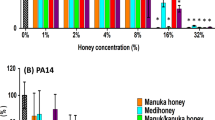Abstract
Biofilm formation in chronic ulcers is an important cause for delayed healing of wounds. Eradication of biofilms is a challenge as this is not amenable to standard methods of ulcer management. Currently, there are very limited options for its eradication except manual debridement which is painful, needs repeated anesthesia, and cannot be done on daily basis. Unprocessed naturally extracted honey has multiple unique properties as a local applicant which aid in faster healing. This article presents the incidence of biofilms in chronic ulcers and use of honey as a local applicant in enhancing healing. Sixty-four patients with ulcers were studied for presence of biofilm. Among them, 43 (67%) had biofilms which took significantly long time to heal in comparison with ulcers without biofilms (p < 0.002). Later, efficacy of honey in eradication of biofilms was studied in 56 patients with chronic ulcers having biofilms. There was a significant reduction in time for eradication, (p < 0.0175) healing of ulcers, and total duration of hospital stay in comparison with ulcers managed by standard methods. Results suggest that natural unprocessed honey has a great potential in eradication of biofilms.



Similar content being viewed by others
References
Cowan LJ, Stechmiller JK, Phillips P, Yang Q, Schultz G (2013) Chronic wounds, biofilms and use of medicinal larvae. Ulcers. https://doi.org/10.1155/2013/287024:1-7
Sun Y, Dowd SE, Smith E (2008) In vitro multispecies Lubbock chronic wound biofilm model. Wound Repair Regen 16:805–801
Percival SL, Cutting KF (2009) Biofilms: possible strategies for suppression in chronic wounds. Nurs Stand 23:64–72
Abdul Rani S, Hoon R, Najafi R, Khosrovi B, Wang L, Debabov D (2014) The in-vitro antimicrobial activity of wound and skin cleansers at non-toxic concentrations. Adv Skin Wound Care 27:65–69
Trengove NJ, Stacey MC, MacAuley S (1999) Analysis of the acute and chronic wound environments: the role of proteases and their inhibitors. Wound Repair Regen 7(6):442–452
Schultz GS, Sibbald RG, Falanga V (2003) Wound bed preparation: a systematic approach to wound management. Wound Repair Regen 11(Suppl 1):S1–S28
Hibbing ME, Fuqua C, Parsek MR, Peterson SB (2010) Bacterial competition: surviving and thriving in the microbial jungle. Nat Rev Microbiol 8(1):15–25
Wolcott RD, Rhoads DD (2008) A study of biofilm-based wound management in subjects with critical limb ischaemia. J Wound Care 17(4):145–155
James GA, Swogger E, Wolcott RD (2008) Biofilms in chronic wounds. Wound Repair Regen 16(1):37–34
Black CE, Costerton JW. (2010) Current concepts regarding the effect of wound microbial ecology and biofilms on wound healing. Surg Clin North Am [internet]. [cited 2013 Oct 16]; 90(6):1147–60. Available from: http://www.sciencedirect.com/science/article/pii/S003961091000109X
Finnegan S, Percival SL (2015) Clinical and antibiofilm efficacy of antimicrobial hydrogels. Adv Wound Care 4(7):398–406. https://doi.org/10.1089/wound.2014.0556
Trengove NJ, Langton SR, Stacey MC (1996) Biochemical analysis of wound fluid from non healing and healing chronic leg ulcers. Wound Repair Regen 4(2):234–239
Sansonetti PJ, Di Santo JP (2007) Debugging, how bacteria manipulate the immune response. Immunity 26(2):149–161
Costerton JW, Stewart PS, Greenberg EP (1999) Bacterial biofilms: a common cause of persistent infections. Science 284(5418):1318–1322
Edwards R, Harding KG (2004) Bacteria and wound healing. Curr Opin Infect Dis 17:91–96
Prince LR, Bianchi SM, Vaughan KM (2008) Subversion of a lysosomal pathway regulating neutrophil apoptosis by a major bacterial toxin, pyocyanin. J Immunol 180(5):3502–3511
Toth B, Alexander M, Daniel T, Chaudry IH, Hubbard WJ, Schwacha MG (2004) The role of gammadelta T cells in the regulation of neutrophil-mediated tissue damage after thermal injury. J Leukoc Biol 76(3):545–552
Nadell CD, Xavier JB, Levin SA, Foster KR (2008) The evolution of quorum sensing in bacterial biofilms. PLoS Biol 6:1 e14
Jull AB, Cullum N, Dumville JC, Westby MJ, Deshpande S, Walker N (2015) Honey as a topical treatment for wounds (review). Cochrane Database Syst Rev (3):CD005083. https://doi.org/10.1002/1465/858.cd005083.pub4 www.cochranelibrary.com
Kilty SJ, Duval M, Chan FT, Ferris W, Slinger R (2011) Methylglyoxal: (active agent of manuka honey) in vitro activity against bacterial biofilms. Int Forum Allergy Rhinol 1:348–350. https://doi.org/10.1111/.1742-481x.2012.01097x
Lee JH, Park JH, Kim JA, Neupane GP, Cho MH, Lee CS, Lee J (2011) Low concentration of honey reduce biofilm formation, quorum sensing and virulence of E. Coli 0157:H7. Biofouling 27:1095–1104. https://doi.org/10.1080/08927014.2011.633704
Maddocks SE, Lopez MS, Rowlands RS, Cooper RCA (2012) Manuka honey inhibits the development of S. pyogenes biofilms and causes reduced expression of two fibronectin binding proteins. Microbiology 158:781–790. https://doi.org/10.1099/mic.0.53959-0
Mathur T, Singhal S, Khan S, Upadhyay D, Fatma T, Rattan A (2006) Detection of biofilm formation among the clinical isolates of staphylococci: an evaluation of three different screening methods. Indian J Med Microbiol [internet]. [cited 2013 Oct 20];24(1):25
Wolcott RD, Rhoads DD (2008) Management of diabetic ulcer. J Wound Care 17:145–148
Donlan RM (2000) Role of biofilms in antimicrobial resistance. ASAIO J 46:4752
Yager DR, Nwomeh BC (1999) The proteolytic environment of chronic wounds. Wound Repair Regen 7(6):433–441
Armstrong DG, Jude EB (2002) The role of matrix metalloproteinases in wound healing. J Am Podiatr Med Assoc 92(1):12–18
Nwomeh BC, Yager DR, Cohen IK (1998) Physiology of the chronic wound. Clin Plast Surg 25(3):341–356
Hussain MB, Hannan A, Akhtar N, Fayyaz GQ, Imran M, Saleem S, Qureshi IA (2015) Evaluation of antibacterial activity of selected Pakistani honeys against multidrug resistant Salmonella typhi. BMC Complement Altern Med 15(3231):32
Acknowledgements
The authors acknowledge the help and guidance of Dr. Prashant Parandekar, Prof. Dr. Praveen Shahapur, Prof and HOD, Microbiology, Prof K. K. Das, Prof of Physiology and authorities of the Institute for their support and guidance.
Author information
Authors and Affiliations
Corresponding author
Ethics declarations
Conflict of Interest
The authors declare that they have no conflict of interest.
Rights and permissions
About this article
Cite this article
Vallabha, T., Ragate, A.S., Sindgikar, V. et al. Is Honey an Answer for Eradication of Biofilms?. Indian J Surg 81, 144–149 (2019). https://doi.org/10.1007/s12262-018-1747-y
Received:
Accepted:
Published:
Issue Date:
DOI: https://doi.org/10.1007/s12262-018-1747-y




